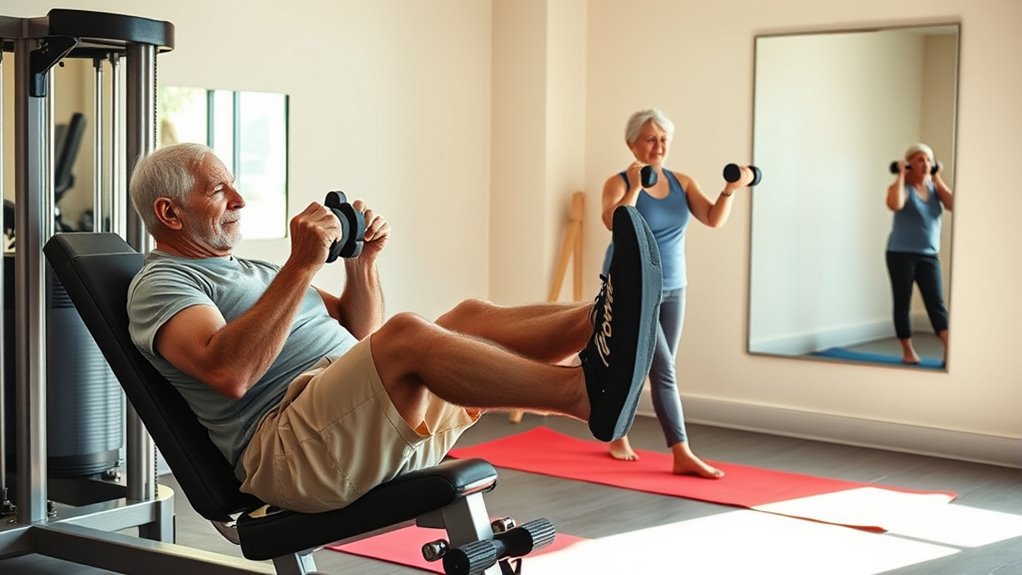Strength training is essential for staying strong after 70. It combats muscle loss, enhances bone density, and supports cardiovascular health. Start with bodyweight exercises to master your form, aiming for three sets of 10 to 15 repetitions, at least twice a week. Don’t forget to consult your doctor and allow recovery time. Key exercises include squats and seated rows, which you can progress safely. Stick around to explore more effective tips and exercises tailored just for you.
Key Takeaways
- Start with bodyweight exercises to master form and build foundational strength before progressing to weights or resistance bands.
- Aim for strength training sessions at least twice a week, allowing recovery time between workouts for optimal muscle benefits.
- Focus on functional movements like squats and lunges to enhance balance, coordination, and overall mobility.
- Use a progressive approach by gradually increasing weight or resistance, ensuring that form remains a priority to prevent injury.
- Stay hydrated and incorporate mindfulness techniques to support physical performance and mental clarity during workouts.
Understanding the Importance of Strength Training for Seniors

As you age, maintaining your strength becomes essential for your mobility and independence.
Strength training is important for older adults, as it combats age-related muscle loss, known as sarcopenia, which can begin around age 30. The benefits of strength training extend beyond just muscle strength; it also enhances bone density, reducing your risk of osteoporosis and fractures. Regular consumption of high-fiber foods, such as chia seeds, can further support your digestive health while you engage in strength training. Additionally, engaging in regular physical activity is aligned with global health initiatives aimed at improving health systems for older populations. Furthermore, staying aware of health issues such as breast cancer can empower seniors to prioritize their overall well-being. Incorporating regular exercise into your routine can also help manage retirement planning, ensuring a sustainable lifestyle.
Strength training is vital for older adults, fighting muscle loss and boosting bone density to prevent osteoporosis and fractures.
Regular exercise, especially resistance training, can lower your risk of heart attack or stroke by up to 70%, showcasing significant cardiovascular benefits. Additionally, incorporating high-fiber foods like chia seeds into your diet can help reduce hunger and support your weight management goals.
Strength training improves balance and coordination, which is critical for fall prevention. Incorporating it into your routine can also help manage chronic conditions like diabetes, leading to better overall health outcomes.
Stay strong and active!
Health Benefits of Strength Training After 70

Strength training offers remarkable health benefits for those over 70, especially when it comes to maintaining independence and preventing injuries. Engaging in strength training helps combat sarcopenia, the age-related loss of muscle mass that affects nearly 30% of older adults.
By increasing muscle mass, you can reduce frailty and improve mobility, which is essential for falls prevention—one in four older adults experiences a fall each year. Additionally, strength training enhances bone density, lowering the risk of osteoporosis-related fractures.
It also greatly boosts cardiovascular health, reducing the risk of heart attacks or strokes by up to 70%. Finally, regular strength training is linked to improved mental health, helping you feel better and slow cognitive decline. Moreover, incorporating diversification benefits through various strength training exercises can further enhance overall physical performance and resilience.
Getting Started With Strength Training: Essential Tips

Getting started with strength training can feel overwhelming, but it doesn’t have to be. Begin with bodyweight exercises to master proper form, aiming for three sets of 10 to 15 repetitions to build a solid foundation.
Here are some essential tips:
- Incorporate basic movements like lunges, wall pushups, and hip hinges. Engaging in creative storytelling about your fitness journey can also motivate you to stay consistent. Additionally, understanding plant properties can enhance your approach to nutrition and recovery. Using educational toys can also promote physical activity and coordination, similar to how strength training enhances muscle function. To support your training, consider mineral-based sunscreens to protect your skin during outdoor workouts.
- Engage in strength training at least twice a week on non-consecutive days.
- Consider joining group fitness classes like SilverSneakers for support and guidance.
- Always consult with a healthcare professional before starting, especially if you have chronic conditions.
- Allow recovery time to maximize muscle benefits and prevent injury. Additionally, incorporating gentle methods can help ensure a safe and effective training experience.
Key Strength Exercises for Older Adults

When it comes to strength training, focusing on key exercises can make a big difference in your fitness journey. You can easily modify these movements for safety while reaping functional benefits that enhance your daily life. Incorporating multifunctional furniture in your exercise space can help maintain an organized environment that supports your fitness routine. Additionally, ensuring you have a good understanding of financial considerations for elderly care can alleviate stress about health-related expenses. Let’s explore some essential exercises that will help you build strength and maintain your independence. Additionally, incorporating omega-3 fatty acids into your diet can support muscle recovery and overall health as you age. Staying hydrated is also crucial, as dehydration can negatively affect physical performance and recovery, particularly in older adults, so consider drinking fresh juice regularly. Including a protein-rich breakfast can also provide the energy needed for your exercise routine and aid in muscle repair.
Essential Strengthening Exercises
Incorporating essential strengthening exercises into your routine can greatly enhance your overall health and well-being as you age. For seniors over 70, these exercises are crucial for maintaining independence and mobility.
Focus on these key movements:
- Squats (use a chair for support to strengthen lower body)
- Incline Pushups (adjustable to build upper body strength)
- Seated Rows (great for back muscles and posture)
- Stationary Lunges (ensure proper form for leg strength and stability)
- Functional Movements (integrate daily tasks into your routine)
Using bodyweight, resistance bands, or weight machines, these essential strengthening exercises will help you stay strong and active. Regular exercise is vital for overall health and can contribute to improved emotional well-being. Furthermore, engaging in mindfulness and relaxation techniques can complement your physical activities and enhance your mental clarity. Additionally, staying hydrated with freshly squeezed juices can support your overall nutrition and energy levels. It’s also important to stay aware of newborn safety guidelines if you are caring for young ones while engaging in your fitness routine. Engaging in community activities can also provide social support and motivation to stay active.
Embrace these workouts to improve your quality of life and retain your independence.
Safe Exercise Modifications
Safety should always be a priority when engaging in strength training, especially for older adults. You can make safe exercise modifications to enhance your routine.
For lower body strength, try squats using chair support to maintain proper form. Incline pushups serve as a fantastic upper body exercise; start higher and gradually lower the incline as your strength improves. Individuals engaging in physical activity should also be aware of their emotional regulation to ensure a positive experience. Glycolic acid can also be beneficial for improving skin tone and texture, which may enhance your confidence during workouts.
Seated rows with resistance bands are perfect for strengthening your back while seated, minimizing injury risk. For leg strength, simplify stationary lunges by holding onto a sturdy surface for balance.
Finally, the Dead Bug exercise allows for core engagement by keeping your legs bent, which helps prevent back strain. Additionally, incorporating essential oils for muscle recovery can enhance your overall wellness routine and aid in post-workout relaxation. These modifications guarantee you stay strong and safe during your workouts.
Functional Movement Benefits
Engaging in key strength exercises can substantially enhance your functional movement, making daily tasks easier and safer. By focusing on strength exercises, you’ll improve muscle strength, bone density, and overall physical function.
This not only boosts your mobility but also plays an essential role in falls prevention. Here are some key benefits:
- Enhanced core stability for better balance
- Increased confidence in daily activities
- Improved ability to climb stairs and lift objects
- Greater ease in sitting down and standing up
- A significant boost in your overall quality of life
Incorporating exercises like squats, push-ups, and lunges into your routine can demonstrate clear benefits, making you feel more empowered and active in your everyday life.
Progressing Safely: From Bodyweight to Weights

As you start your weight training journey, it’s crucial to establish a strong foundation with bodyweight exercises like squats, lunges, and push-ups. Focus on proper form to build strength before progressing to weights.
Once you’re comfortable, incorporate the lightest dumbbells or resistance bands, gradually increasing the weight as needed. Aim for three sets of 10 to 15 repetitions, guaranteeing you allow time for muscle recovery, which may take longer as you age.
Incorporate light weights or resistance bands, aiming for three sets of 10-15 reps while prioritizing muscle recovery.
Consider consulting a personal trainer to enhance safety and guarantee effective progression to weights. Monitor your body’s response, adjusting intensity to maintain a Rate of Perceived Exertion of about 7 out of 10 for strength exercises.
This approach will help you progress safely and effectively.
Creating a Consistent Workout Schedule

After you’ve established a solid foundation in weight training, creating a consistent workout schedule can greatly enhance your progress. Aim for at least two strength training sessions each week, focusing on various muscle groups like upper body, lower body, and core.
Here are some tips to help you stay on track:
- Start with shorter 10-15 minute sessions and gradually increase as your fitness levels improve.
- Use a calendar or fitness app to track your workouts and maintain consistency.
- Join group classes, like SilverSneakers, for motivation and community support.
- Schedule non-consecutive days to guarantee recovery.
- Mix in different exercises to keep your routine fresh and engaging.
Sticking to a workout schedule will help you build strength and improve your senior fitness.
Safety Guidelines and Recommendations for Strength Training

When starting a strength training program, it’s important to prioritize safety to prevent injuries and secure effective workouts. Here are some key safety guidelines to follow:
| Guidelines | Recommendations |
|---|---|
| Talk to your doctor | Consult before starting any program |
| Engage a personal trainer | Learn proper form for exercises |
| Start with bodyweight exercises | Use light weights for initial sets |
| Schedule workouts | Train twice a week on non-consecutive days |
Always monitor discomfort during workouts. If you experience swelling or sharp pain, adjust your routine and seek medical advice. Start with three sets of 10-15 repetitions, only increasing intensity when you feel confident. Remember, exercising safely secures long-term benefits!
Frequently Asked Questions
What Is the Best Strength Training for a 70 Year Old?
The best strength training for you at 70 focuses on bodyweight exercises and light weights. Incorporate movements like squats, incline pushups, and seated rows to engage your muscles effectively.
Aim for at least two sessions a week, allowing for recovery in between. Functional movements, such as chair rises and lunges, enhance your mobility and lower fall risks.
Start with the lightest weights or resistance bands, and consult a trainer for guidance on proper form.
How Many Times a Week Should a 70 Year Old Lift Weights?
You should aim to lift weights at least twice a week. This frequency helps maintain muscle mass and supports overall health.
If you’re just starting out, consider shorter sessions of 10 to 15 minutes, gradually increasing as you gain strength. Training three to four times a week might offer the best results, but always listen to your body.
How Can I Build Muscle Strength After 70?
Think of your body as a garden; with the right care, it can flourish even after 70.
To build muscle strength, start with bodyweight exercises like squats and lunges to master your form. Aim for strength training twice a week, focusing on major muscle groups.
Gradually add light weights or resistance bands as you grow stronger. Always consult a healthcare professional to guarantee your routine is safe and effective, nurturing your body’s growth.
How Can I Stay Strong After 70?
To stay strong after 70, focus on engaging in regular physical activity that challenges your muscles.
Aim for strength training at least twice a week, incorporating bodyweight exercises and light weights.
Prioritize functional movements like squats and lunges to enhance your daily performance.
Always pay attention to your form to avoid injuries, and don’t forget to allow your body time to recover.
Listening to your body is key to maintaining your strength and mobility.
Conclusion
Incorporating strength training into your routine can be a game-changer after 70. Not only does it boost your strength and balance, but it also enhances your overall quality of life. So, why not take that first step toward a stronger you? Remember, it’s never too late to start. With the right exercises, a consistent schedule, and a focus on safety, you can enjoy the many benefits of staying strong and healthy well into your golden years.










